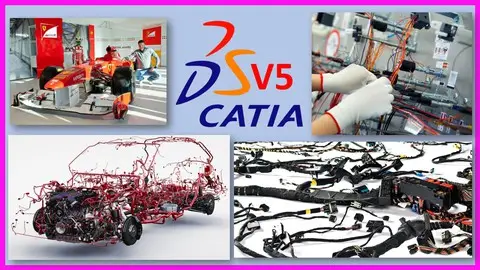Catia V5 Electrical Harness Design - Theory & Practice
Published 9/2022
MP4 | Video: h264, 1280x720 | Audio: AAC, 44.1 KHz
Language: English | Size: 7.69 GB | Duration: 10h 16m
Published 9/2022
MP4 | Video: h264, 1280x720 | Audio: AAC, 44.1 KHz
Language: English | Size: 7.69 GB | Duration: 10h 16m
Learn automotive electrical harness design from an engineer with more than 18 years experience
What you'll learn
Electrical Harness Design Process from A to Z
Electrical Harness Manufacturing Process
Electrical Harness materials and components in automotive
Harness design rules, requirements and challenges
The basics for selecting harness components like: connectors, wires, relays, fuses, splices and others
Practice projects where we implement what we learn
Many other concepts and secrets in automotive electrical harness design
Learn how to create a portfolio, CV and how to conduct yourself at an interview
Advices and info for the Electrical Harness Design interview
Requirements
To take this course you need to know in advance the following Catia V5 workbenches: Part Design, Assembly Design, Electrical Part Design, Electrical Assembly Design, Electrical Harness Installation, Electrical Harness Assembly
You need to have basic electrical knowledge for this course
You need to have Catia V5 installed with the licenses mentioned above
Description
HiMy name is Alex, and I am a Design Engineer.I have been working for more than 18 years with Catia V5 in automotive engineering, racing and industrial design.All the knowledge and experience that I gained helped me work with companies likeFerrari Formula One Team, Red Bull Racing, Jaguar Land Rover, Aston Martin and othersIn this course I will show you how to design electrical harnesses for automotive companies.I will explain what is the design process for electrical harnesses and what materials and components are being used.I will also explain what are the design rules and what requirements automotive companies have for harness designNext, I will reveal what is the criteria for selecting electrical components for harnesses like: connectors, pins, wires, relays, fuses, splices and othersAfter all this theory we will design a few CAD projects where we implement everything we learned and I will give you a few assignments and challenges.After the projects we will make a few small projects to touch on more harness design techniques that you need to knowI design with Catia V5 but you can design this in any other CAD software as I provide step files.In the last section of the course, we discuss about how to tailor your CV, how to conduct yourself at an interview and how to create a portfolioWith all of this said. This course is a cheat code.To be able to take chance on opportunities you need experience, and experience is built only with practice.Thanks for watching this video and see you in the course.
Overview
Section 1: Introduction
Lecture 1 Introduction
Lecture 2 Add subtitles in your language
Lecture 3 What you need to take this course
Lecture 4 How to use the step files
Section 2: Electrical harness design and production process
Lecture 5 1 - The purpose of 3D harness design in automotive
Lecture 6 2 - Electrical harness families and complexity
Lecture 7 3 - Automotive harness components
Lecture 8 4 - Automotive harness component resources
Lecture 9 5 - Automotive harness manufacturing and design process
Lecture 10 6 - Electrical harness design jobs and responsibilities in automotive
Section 3: Electrical harness component selection criteria guide
Lecture 11 Connector selection criteria
Lecture 12 The relationship between connectors, pins, wires and power
Lecture 13 Wires selection criteria
Lecture 14 Relay selection criteria
Lecture 15 Fuse selection criteria
Lecture 16 Splice selection criteria
Section 4: Main cabin electrical harness selection
Lecture 17 Electrifying connectors part 1
Lecture 18 Electrifying connectors part 2
Lecture 19 Electrifying connectors part 3
Lecture 20 Positioning the connectors
Lecture 21 Routing wire bundles part 1
Lecture 22 Routing wire bundles part 2
Lecture 23 Routing wire bundles part 3
Lecture 24 Routing wire bundles part 4
Lecture 25 Routing wire bundles part 5
Lecture 26 Routing wire bundles part 6
Lecture 27 Routing wire bundles part 7
Lecture 28 Routing wire bundles part 8
Lecture 29 How to calculate bundle diameters for electrical harnesses
Lecture 30 Updating bundle diameters
Lecture 31 Adding slack and making adjustments
Lecture 32 Adding slack everywhere
Lecture 33 Analizing the project and highlighting issues
Lecture 34 Dimension and drawings for the harness manufacturing plant
Section 5: Underbody electrical harness selection
Lecture 35 Project introduction
Lecture 36 Connector electrification and product preparation
Lecture 37 Position connectors and clips
Lecture 38 Routing wire bundles part 1
Lecture 39 Routing wire bundles part 2
Lecture 40 Calculating and updating bundle diameters
Lecture 41 Adding slack and making adjustments
Lecture 42 Investigating issues and and finding solutions
Lecture 43 Finishing the harness
Lecture 44 Final assignment for this project
Section 6: Harness design techniques
Lecture 45 Connector detailing - tensioned wires
Lecture 46 Electrical harness dynamics techniques part 1 - seats
Lecture 47 Seat harness dynamics part 2
Lecture 48 Underbody harness dynamics
Lecture 49 Grommet installation basics
Lecture 50 Poka Yoke in electrical harness design
Aspiring Electrical Harness Designers,Aspiring EDS Designers (this is NOT a complete EDS/circuit/diagram design course),Non electrical students that want to become Electrical Harness designers (you need to learn basic electricity on your own),Any Designer or Engineer that wants to know more about this industry



